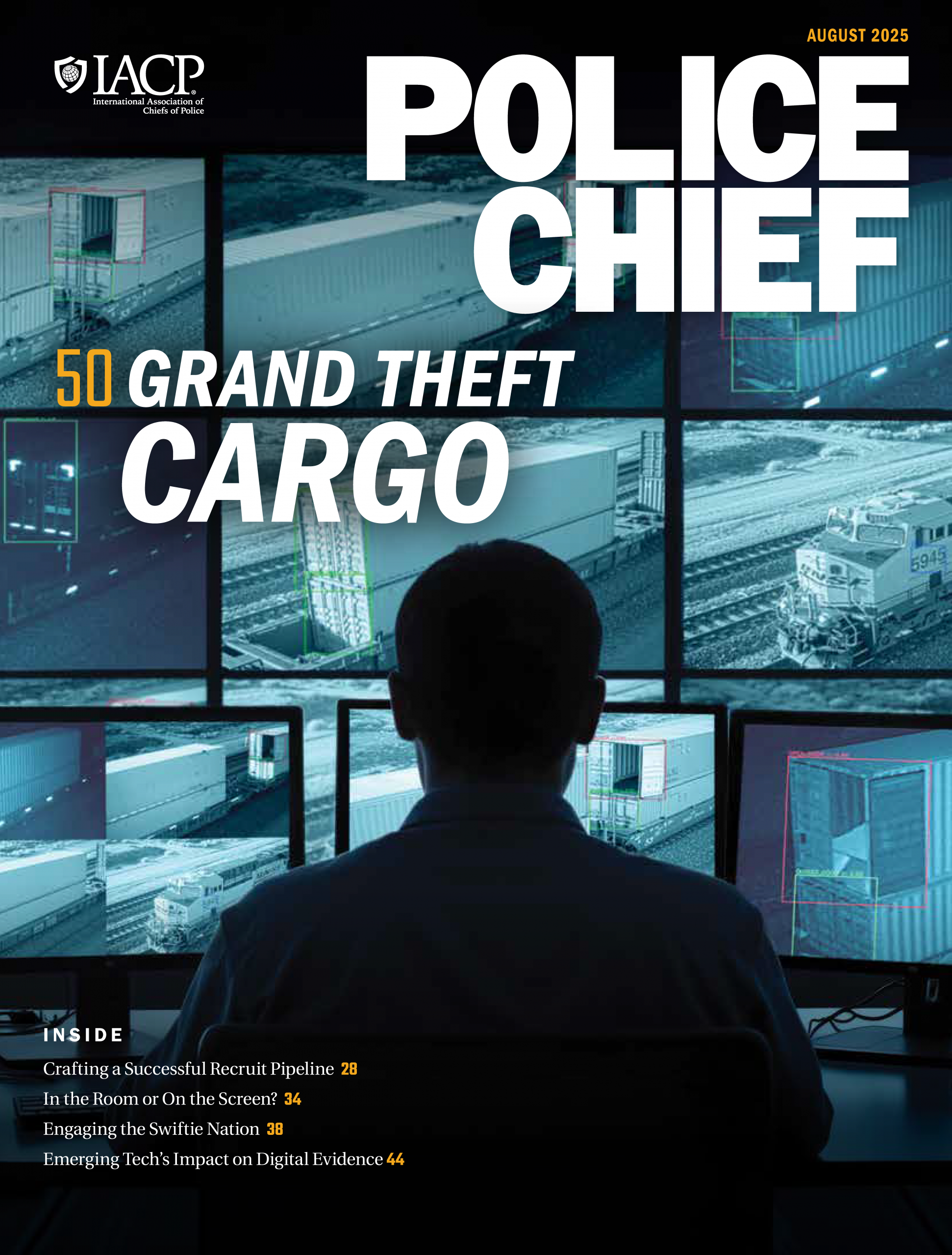
We are amid an unprecedented fatal and nonfatal overdose epidemic, and in my over 30 years of law enforcement experience, the devastation and violent crime resulting from illicit drugs—from their manufacture, sale, and use—have never been so far-reaching or destructive.
Worldwide, about 600,000 deaths annually are attributable to drug use. Nearly 80 percent of these deaths are related to opioids.1 Today, the most prominent illicit drug impacting our communities is fentanyl, which is highly addictive and easy and cheap to manufacture.
Addressing this growing threat requires a comprehensive strategy beyond traditional enforcement and must include a strong focus on investigation, prosecution, community education, harm reduction, substance use prevention, treatment, and recovery support services.
As we all know, illicit drug markets fuel violent crime in our communities, especially as street gangs, the primary sellers of illicit drugs, vie for control of the marketplace. On a global level, the illicit drug market produces enormous profits used to finance transnational criminal and terrorist activity.
Drug traffickers and producers care only about one thing—profit. Human life and the well-being of our communities mean nothing to them so long as they can continue to sell and manufacture cheap and easy-to-produce products like fentanyl that are highly addictive and increase their profit margins.
As a profession, we need to fight these drug networks by going to the source. Working with other parts of the criminal justice system, we must interrupt the chemical supply chain by regulating precursor chemicals and closing the factories that produce them. Recently, the U.S. government indicted and sanctioned several Chinese chemical companies and executives who exported precursor chemicals into North America, but there is more work to be done. We also need to collaborate with our global partners to shut down clandestine labs used to produce fentanyl and interdict the illicit drugs being smuggled into our communities. Many of these precursor chemicals are frequently sent to Mexico, where transnational criminal organizations, specifically the Sinaloa and Jalisco Cartels, produce deadly fentanyl. We must continue to actively pursue and try to disrupt these cartels.
As a profession, we need to fight these drug networks by going to the source.
This includes the growing shift in the way we prosecute dealers—the lower-
level/street network of gangs and cartels—so we can hopefully take down the entire network. This is why many law enforcement agencies are now classifying overdoses as homicides or poisonings. Recently, in California, San Francisco’s mayor and top law enforcement officers announced that drug dealers linked to fatal overdoses could stand trial for murder.2 Investigating overdose incidents as criminal activity allows police to investigate and identify the supply source, which can help prevent further tragedies.3 While not always easy to enforce, many states have drug-induced homicide laws that can be used to prosecute individuals who sell and distribute illicit drugs.4 By focusing on the criminal networks perpetuating the drug crisis, law enforcement can proactively save potential victims by removing the threat altogether.
Such a widespread and lethal problem requires law enforcement to use every resource at our disposal. The Overdose Detecting Mapping Application Program (ODMAP) database is a tremendous tool in the United States and should be adopted globally. ODMAP provides near real-time suspected overdose data across jurisdictions to support public safety and public health efforts to mobilize an immediate response to a sudden increase, or spike, in overdose events. ODMAP allows first responders to map out and track overdoses in order to enhance response and provide strategic analysis across jurisdictions. If your agency isn’t already participating in and utilizing ODMAP, I highly encourage you to do so.
In the United States, the U.S. Drug Enforcement Agency (DEA) can also support your agency if your community experiences a mass overdose event, which, unfortunately, is likely, given the scope of this issue. The DEA can help your agency identify and investigate dealers and large drug trafficking organizations; provide priority access to its labs, chemists, and overdose subject matter experts; assist with presenting the investigation to federal prosecutors; and educate the public.5
Investigation, enforcement, and prosecution make up just one element of strategies to prevent the deadly effects of illicit drugs on our communities. Public education and awareness are another major component. The DEA continues to issue public service alerts informing individuals of the prevalence of deadly fake pills laced with fentanyl and xylazine, as well as the methods traffickers use to distribute them. Through social media and internet networks, criminal drug organizations are marketing and dispensing these fake pills as legitimate prescription medicine.6 Oftentimes, it is difficult to distinguish the real pills from the fake ones. For individuals who think they are purchasing inexpensive prescription medicine, this misperception has had deadly consequences.
Through the One Pill Can Kill campaign, the DEA is working to educate the public about the production, marketing, and catastrophic effects of fake prescription pills, urging people to take prescribed medicine dispensed only by licensed pharmacists. While it’s ill-advised to take a drug bought elsewhere, should someone be unsure of a drug’s contents, the DEA also promotes the use of fentanyl test strips to detect the presence of fentanyl in different kinds of drugs to prevent accidental ingestion or exposure.
Additionally, police and communities are asking family and friends who have lost someone to fentanyl and illicit drugs to speak out and bring the kind of awareness, advocacy weight, and attention that we know will save lives. Hearing these tragic and painful stories raises awareness in communities, particularly among our youth.
In my agency, we have started holding educational drug presentations for parents. During these presentations, my detectives review local narcotic trends, signs and symptoms, methods of use, and the hazards associated with drug use. These presentations have been highly requested, and attendees say the information is “eye-opening.” Although illicit drugs are running rampant in our communities, many individuals are still unaware of the very real danger they pose. The more we can educate members of our communities, the more likely it is that someone will recognize and report the indicators, allowing us to step in and save lives while at that same time bringing offenders to justice.
As with most complex issues, we need to take a multipronged approach to addressing the ongoing illicit drug problem. Education, investigation, and prosecution are all necessary components to turn the tide in the fight against fentanyl and other illicit drugs. Given the potency of these lethal chemicals, every milligram we get off the street directly translates to lives saved. As we all continue to combat the disastrous effects of these drugs, I urge you all to stay safe and vigilant as you honorably protect your communities.d
Notes:
1World Health Organization, “Opioid Overdose,” fact sheet, August 29, 2023.
2Amy Larson and Dan Kerman, “San Francisco Will Prosecute Fatal Overdose Cases as Murders,” Focus on Fentanyl, Kron4KRON4, October 27, 2023.
3Andrea Lucia, “How Fentanyl Has Changed Overdose Investigations and the Law,” CBSTexas, October 26, 2023.
4Mark Neil, “Prosecuting Drug Overdoes Cases: A Paradigm Shift,” National Association of Attorneys General, February 12, 2018.
5U.S. Drug Enforcement Administration (DEA), “DEA Warns of Increase in Mass-Overdose Events Involving Deadly Fentanyl,” press release, April 6, 2022.
6DEA, “Fake Pills Fact Sheet,” September 2023.
Please cite as
Wade Carpenter, “Current Drug Trends Demand a Comprehensive Study,” President’s Message, Police Chief 91, no. 1 (January 2024): 6–7.


